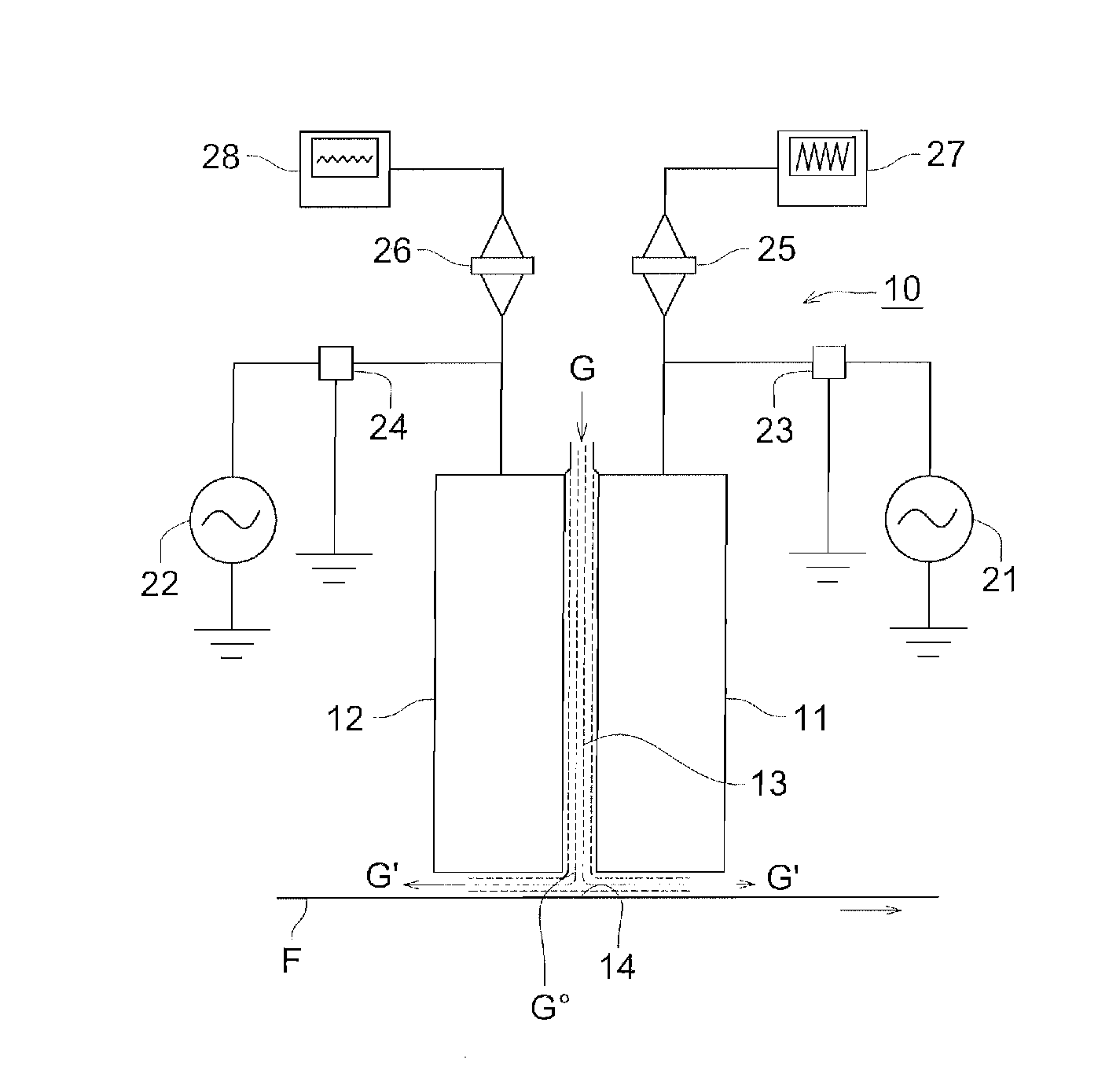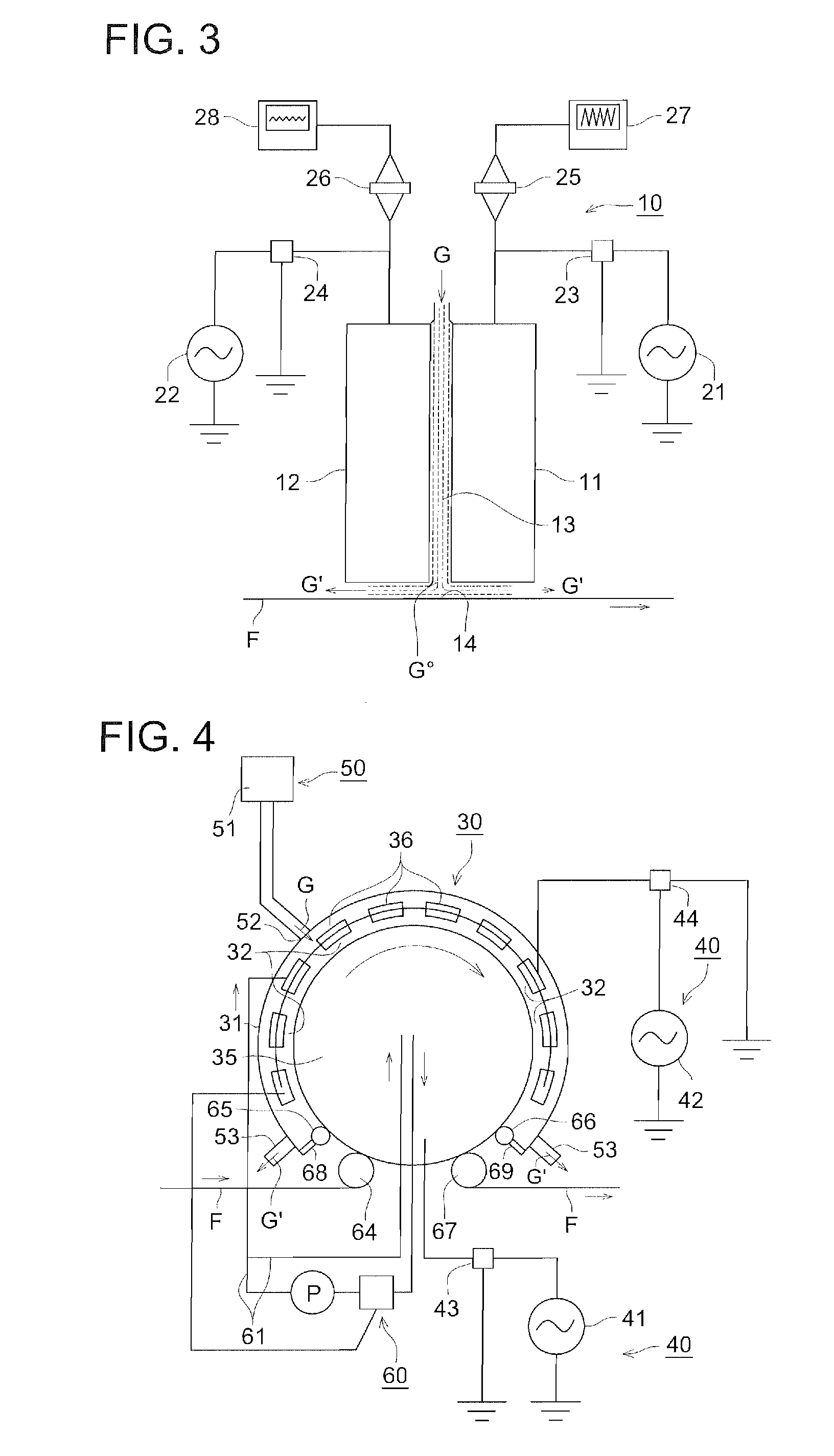Gas barrier film, gas barrier film manufacturing method, resin substrate for organic electroluminescent device using the aforesaid gas barrier film, and organic electroluminescent device using the aforementioned gas barrier film
a gas barrier film and manufacturing method technology, applied in the field of gas barrier films, can solve the problems of aluminum foil completely failing to meet the requirements of aluminum foil packaging, the contents of the packaging cannot be identified from outside, and the disposal has not yet been found, so as to achieve excellent adhesion, high resistance to cracks, and high durability
- Summary
- Abstract
- Description
- Claims
- Application Information
AI Technical Summary
Benefits of technology
Problems solved by technology
Method used
Image
Examples
example 1
[0324]Plasma discharge processing was performed using the roll electrode type discharge processing apparatus shown in FIG. 4, and a ceramic film was formed on the substrate film. In the discharge processing apparatus, a plurality of rod-like electrodes were placed face to face with the roll electrode, parallel to the conveying direction of the film in such a way that the materials (discharge gas, reaction gas 1, 2 (to be described later)) can be supplied to each electrode.
[0325]The dielectric for coating each electrode, together with the opposing electrode, was coated on the ceramic sprayed electrode to a thickness of 1 mm on one side. After coating, the gap between the electrodes was set to 1 mm. Further, the base metal coating the dielectric was designed as a stainless steel jacket having a cooling function by coolant. Electrode temperature was controlled by coolant during the process of discharging. The light source used in this case was a high frequency power source manufactured...
example 2
[0361]A film having the following thickness was formed on the substrate according to the same procedure as that used in the Example 1, using the Model PD-270STP plasma CVD apparatus of Samco Inc.
[0362]The following describes the film forming conditions for each layer in Samples Nos. 6 through 10:
[0363]
[0364]Oxygen pressure: Gas pressure was changed at 13.3 through 133 Pa
[0365]Reaction gas: Tetraethoxy silane (TEOS), 5 sccm (standard cubic centimeter per minute)
[0366]Power: 100 W at 13.56 MHz
[0367]Retained substrate temperature: 120° C.
[0368]
[0369]The power application was reversed under the aforementioned ceramic layer film making conditions, and the substrate holding side was used as the ground. Then high frequency power was applied to the side of the opposed electrode, whereby a film was formed. The composition of the protective layer and closely bonded layer of each sample was SiO1.48C0.96. The density of the protective layer and closely bonded layer was 2.08 for the sample No. 6...
example 3
[0377]
[0378]A transparent conductive film was formed on the ceramic film of the sample No. 5 of the gas barrier film produced in the Example 1 by the following method.
[0379]A plasma discharging apparatus having parallel flat electrodes was utilized, and the aforementioned transparent film was mounted between these electrodes. Then a gas mixture was introduced to form a thin film.
[0380]In the ground electrode, the stainless steel plate measuring 200 mm×200 mm×2 mm was coated with a closely bonded alumina sprayed film. After that, the solution formed by diluting the tetramethoxy silane with ethyl acetate was coated and dried. Then it was cured by ultraviolet rays, and was provided with pore sealing treatment. Then the dielectric surface coated in this manner was polished and smoothed, and the electrode was process so that the Rmax value would be 5 μm. The applied electrode used was arranged in such a way that the hollow rectangular pure titanium pipe was coated with the dielectric und...
PUM
| Property | Measurement | Unit |
|---|---|---|
| thickness | aaaaa | aaaaa |
| voltage | aaaaa | aaaaa |
| 2θ/ | aaaaa | aaaaa |
Abstract
Description
Claims
Application Information
 Login to View More
Login to View More - R&D
- Intellectual Property
- Life Sciences
- Materials
- Tech Scout
- Unparalleled Data Quality
- Higher Quality Content
- 60% Fewer Hallucinations
Browse by: Latest US Patents, China's latest patents, Technical Efficacy Thesaurus, Application Domain, Technology Topic, Popular Technical Reports.
© 2025 PatSnap. All rights reserved.Legal|Privacy policy|Modern Slavery Act Transparency Statement|Sitemap|About US| Contact US: help@patsnap.com



